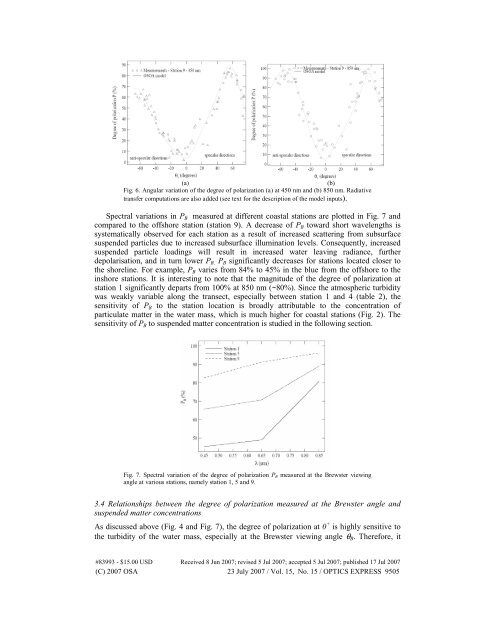Determination of biogeochemical properties of marine particles ...
Determination of biogeochemical properties of marine particles ...
Determination of biogeochemical properties of marine particles ...
You also want an ePaper? Increase the reach of your titles
YUMPU automatically turns print PDFs into web optimized ePapers that Google loves.
(a)<br />
(b)<br />
Fig. 6. Angular variation <strong>of</strong> the degree <strong>of</strong> polarization (a) at 450 nm and (b) 850 nm. Radiative<br />
transfer computations are also added (see text for the description <strong>of</strong> the model inputs).<br />
Spectral variations in P B measured at different coastal stations are plotted in Fig. 7 and<br />
compared to the <strong>of</strong>fshore station (station 9). A decrease <strong>of</strong> P B toward short wavelengths is<br />
systematically observed for each station as a result <strong>of</strong> increased scattering from subsurface<br />
suspended <strong>particles</strong> due to increased subsurface illumination levels. Consequently, increased<br />
suspended particle loadings will result in increased water leaving radiance, further<br />
depolarisation, and in turn lower P B. P B significantly decreases for stations located closer to<br />
the shoreline. For example, P B varies from 84% to 45% in the blue from the <strong>of</strong>fshore to the<br />
inshore stations. It is interesting to note that the magnitude <strong>of</strong> the degree <strong>of</strong> polarization at<br />
station 1 significantly departs from 100% at 850 nm (~80%). Since the atmospheric turbidity<br />
was weakly variable along the transect, especially between station 1 and 4 (table 2), the<br />
sensitivity <strong>of</strong> P B to the station location is broadly attributable to the concentration <strong>of</strong><br />
particulate matter in the water mass, which is much higher for coastal stations (Fig. 2). The<br />
sensitivity <strong>of</strong> P B to suspended matter concentration is studied in the following section.<br />
Fig. 7. Spectral variation <strong>of</strong> the degree <strong>of</strong> polarization P B measured at the Brewster viewing<br />
angle at various stations, namely station 1, 5 and 9.<br />
3.4 Relationships between the degree <strong>of</strong> polarization measured at the Brewster angle and<br />
suspended matter concentrations<br />
As discussed above (Fig. 4 and Fig. 7), the degree <strong>of</strong> polarization at 0 + is highly sensitive to<br />
the turbidity <strong>of</strong> the water mass, especially at the Brewster viewing angle θ B . Therefore, it<br />
#83993 - $15.00 USD Received 8 Jun 2007; revised 5 Jul 2007; accepted 5 Jul 2007; published 17 Jul 2007<br />
(C) 2007 OSA 23 July 2007 / Vol. 15, No. 15 / OPTICS EXPRESS 9505
















